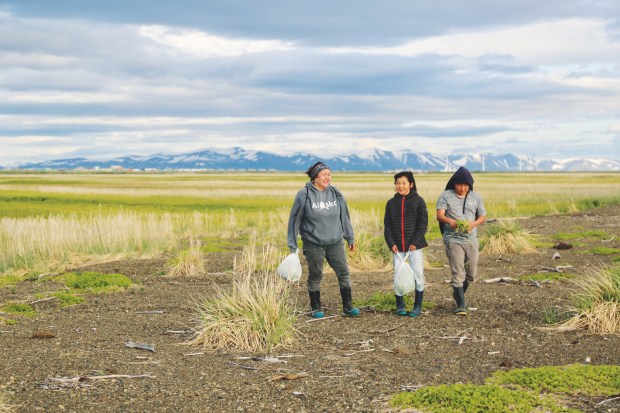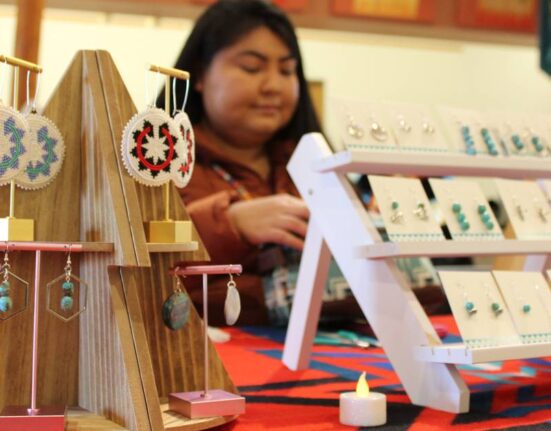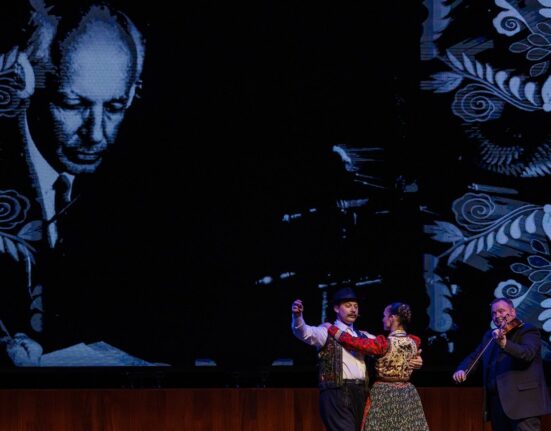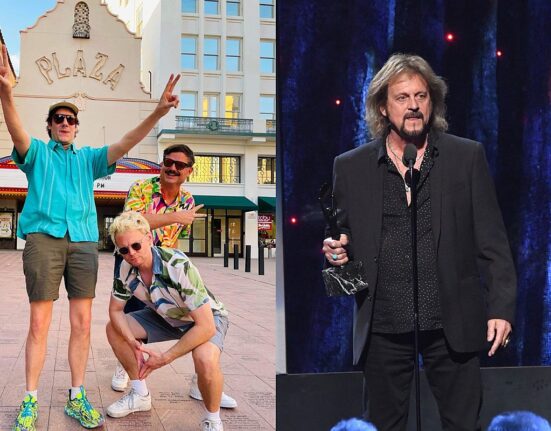Fabulous fashion spreads open “Native America: In Translation,” a thoughtful and wide-ranging group show of nine Indigenous artists at the Museum of Contemporary Photography. Slim, sexy models wear chic clothes, posed against backdrops ranging from a tropical paradise to the white non-space of a commercial studio.
Look carefully, though, and the glossy veneer cracks. The dark-haired mannequins appear to be the same woman throughout, and her makeup goes beyond avant-garde to bizarre. That lush jungle is just a backyard with exotic animals pasted on. An ad for knee-high mod boots seems to be selling flexible notions of identity in addition to patent-leather footwear. And there are a surprising lot of traditional textiles on view, too. Vogue Latinoamérica this is not.
The series is the work of Martine Gutierrez, a queer artist of Mayan heritage who staged, styled, modeled and in every other way created these images, originally publishing them alongside dozens of others in “Indigenous Woman,” her 128-page parody of women’s fashion magazines.
Such self-presentation — of identity, but also of history, daily practices, inspiration and surroundings — is at the heart of “Native America: In Translation.” Who points the camera is key. The traveling show originated as a special issue of the legendary photography journal Aperture, copies of which serve as the MoCPS’s de facto catalog. Inside is some fascinating work unfortunately not up in the galleries, including historical community portraiture by Richard Throssel and Horace Poolaw that provides artistic precedent for the contemporary artists on view. Also missing is Syilx Nation artist Krista Belle Stewart’s immersion in the bizarre world of “Indianthusiasm,” German hobbyists who reenact Native American crafts and rituals during weeklong summer camps, and the piercingly annotated archival materials and decorated snapshots of Wendy Red Star, the Apsáalooke artist who guest edited Aperture 240 and also curated the exhibition.
Aperture had done something similar in 1995, dedicating its summer edition to Native American photographers and writers. Omaskêko Ininiwak artist Duane Linklater was impacted by the copy he had then and intervenes in it here, in the imperturbable series “ghostinthemachine.” Choice pages of the periodical are torn out, folded, sketched on and then scanned, in configurations that allow Linklater plenty of leeway. He highlights a cuttingly sage paragraph by Paul Chaat Smith and a witty self-portrait by Zig Jackson, makes his own contributions via overlaid geometric line drawings, and keeps some things neatly tucked away. Not everything can or should be revealed to everyone.


Nalikutaar Jacqueline Cleveland, an Alaskan native of Yup’ik descent, addresses an extension of this question — how and for whom to photograph the people, places and practices of a community — in her 2019 series, “Ethnobotany Project.” She notes that the intended audience for this work, which forms part of a study funded by the National Science Foundation about variations in diet among Native communities on either side of the Bering Strait and the impact of climate change on their foraging traditions, are local people and students in the field. A small selection of Cleveland’s images shows what might matter to them: a blackberry specimen, labeled in Yup’ik; a 90-year-old elder of Toksook Bay, at home in her qaspeq tunic, bulk cases of Cup Noodles ramen stacked nearby; a mom and her two kids foraging for wild beach greens in Quinhagak; the breathtaking vista and modest structures of Umkumiut, a seasonal hunting and fishing camp. Between the lines of these documentary pictures can be read a text about survival, resistance and negotiation — of traditional language, dress and subsistence practices that continue today, as part of contemporary lives.
Somewhere between documentary and performance stands three immensely powerful images by Rebecca Belmore, a Lac Seul First Nation artist celebrated since the 1990s for artworks orchestrated both for live audiences and for the camera. In “nindinawemaganidog (all of my relations),” she restages key moments from her repertoire, creating striking portraits linked to the lives of Native women real and mythical. “Matriarch” sits with her back to the viewer, face in profile, black hair tumbling down a cloak of blood-red roses hemmed with brown fur. In “keeper,” a woman intently washes the floor with a clay-soaked rag; it stains her garments and becomes the cracked ground on which she kneels. Stories can’t help but attach themselves to these women, stories that recognize their strength, their labor, their centrality and their pain.
By far the most approachable works in “Native America: In Translation” are the exquisitely sincere but never humorless explorations of identity produced by Kimowan Metchewais. The Cree artist amassed a huge personal archive of Polaroids, which he shot, organized, and often cut up, taped together and rephotographed to make small and large-scale artworks. Everything of his at the MoCP is a revelation: a glowing, surreal panorama of himself and his brother fishing while immersed in the infinite blue ripples of Cold Lake, the namesake body of water of their nation; self-portraits in a white tank top, blue jeans and endless hair extensions; Polaroids of his right hand making simple gestures, some with words written underneath, referencing Native traditions of sign language but also, having been erased and rewritten, likely of his own concoction.
Metchewais died in 2011 from a brain tumor at age 47. Like him, we all, whatever our heritage, ultimately must take some charge in our own creation — out of historical traditions, communal norms, but also our own invention.
Lori Waxman is a freelance critic.
“Native America: In Translation” runs through May 12 at the Museum of Contemporary Photography, 600 South Michigan Avenue; more information at 312-369-8067 or mocp.org/exhibition/native-america-in-translation







